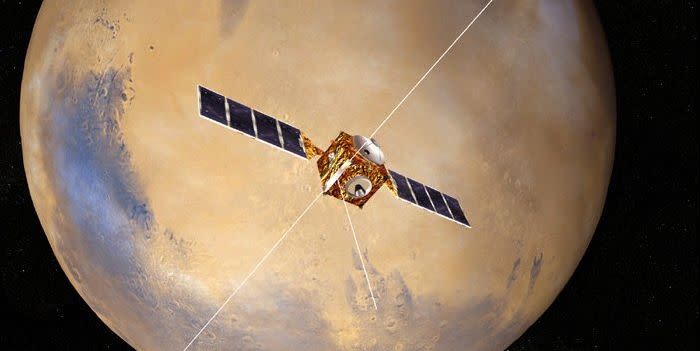How a Deep Space Antenna Just 'Spoke' with Two Spacecraft at Once

The European Space Agency (ESA) announced it has pulled off a technological feat: one of its ground stations transmitted signals to two different deep space spacecraft at once.
Technicians used a backup frequency to send signals to the Mars Express orbiter.
ESA has three deep space ground stations which it uses to communicate with spacecraft exploring the farthest reaches of the solar system.
The European Space Agency (ESA) is celebrating a technical achievement. For the very first time, one of its deep space antennas has simultaneously sent a series of commands to two spacecraft orbiting Mars. The antenna sent parallel transmissions to the agency’s Mars Express orbiter, which snaps pictures of the Red Planet, and its ExoMars Trace Gas Orbiter, which analyzes gas signatures on Mars.
Typically, celestial chatter is limited to communications between one antenna, one spacecraft, and a receiver at a ground station here on Earth. The test could revolutionize communications throughout the solar system, making it easier for Earthlings to communicate with the myriad spacecraft exploring worlds near and far.
The ESA has three deep space ground stations around the world at New Norcia in Australia, Cebreros in Spain, and Malargüe, Argentina. Each station has four receivers and two transmitters. Ground stations are able to accept transmissions from multiple spacecraft at a time. Prior to the recent test at the New Norcia ground station in Australia, these ground stations were only able to speak to one space at a time.
NASA uses the Deep Space Network—complete with three ground stations in California, Spain, and Australia—to send and receive signals to and from the dark corners of the solar system and beyond.
In order to send two signals at once, the antenna had to send the messages over two different frequencies to limit any potential interference. Normally, the two spacecraft send and receive signals on a similar frequency called the X-band, which operates between 8 and 12 GHz, according to an ESA statement. Mars Express, however, can send and receive signals in the lower frequency S-band, which operates around 2.8 GHz and is typically saved for emergency transmissions.
Deep space missions are especially strained at the moment as they require massive antennas with which to communicate. Luckily, this new breakthrough may ease some of the pain.
You Might Also Like

